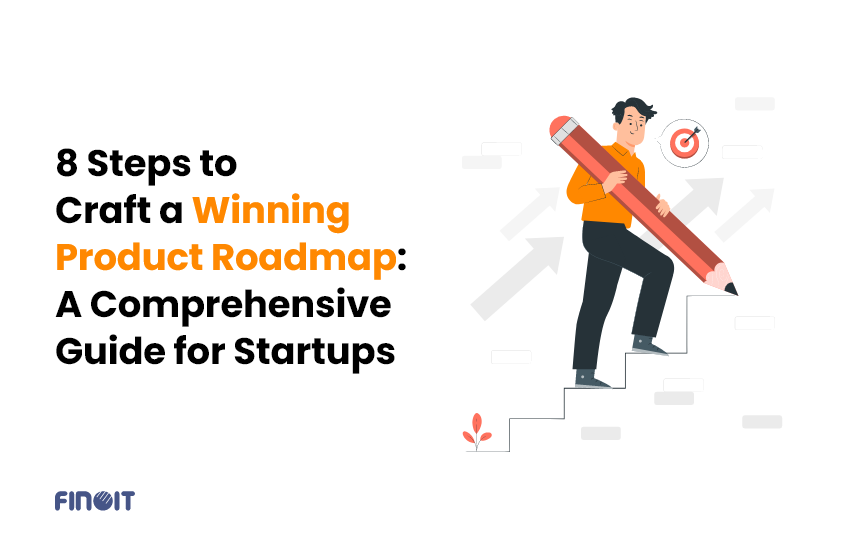8 Steps to Craft a Winning Product Roadmap: A Comprehensive Guide for Startups

We all prepare a to-do task list to accomplish our day-to-day tasks. It helps us to retrospect answers like: Am I planning my action rightly? Or Will my activities today be fruitful in the near future? However, when it comes to software development in startups, a simple task list might not be enough. Numerous factors are involved in this process, which can affect the planned activities. It can be challenging for software developers, stakeholders, and product owners to comprehend the project’s direction, which features must be developed, who is responsible for each task, and other relevant issues.
A product roadmap can summarize the project’s vision and goals over time. It is not just a buzzword in the startup world, but it addresses all the concerns and questions that may arise when creating a new product at a given moment or in the long run. A practical product roadmap requires strategic thinking, customer empathy, market understanding, and collaboration. This article will explore how you can create a roadmap that drives your product toward sustainable growth.
How to create a product roadmap for Startups?
Creating a product roadmap is a strategic planning process that involves several steps. The following is a guide on how to create a practical product roadmap to ensure successful entrepreneurship:
1. Define Your Goals and Objectives
When it comes to creating a product roadmap, having clear goals is crucial. These goals give shape to your startup’s vision by defining the purpose of your product and identifying its target audience. By setting well-defined goals, every member of your team can work towards a common objective and understand how their efforts contribute to the bigger picture. Additionally, breaking down larger goals into smaller, achievable objectives helps prioritize tasks and allocate resources effectively. For example, it may be important to focus on developing a seamless payment system before enhancing personalized recommendations.
With clear goals, you can also track progress and adjust strategies to meet your targets. If your startup’s goal is to acquire 10,000 users in the first quarter, but you have only reached 5,000, this prompts a reassessment of strategies to improve performance. Defining clear goals and objectives acts as a guiding light that will help your business and teams to construct a well-defined product roadmap, allocate resources efficiently, and stay focused on what matters most for their success.
2. Understand Your Target Audience:
To create a successful roadmap, it’s crucial to understand your target audience. This information helps entrepreneurs tailor their software development lifecycle, marketing strategies, and overall roadmap to meet the specific needs and preferences of their intended users. Once you know your audience, you can better resonate with their needs. For example, if your target audience is tech-savvy millennials, your product might emphasize sleek design, seamless mobile experience, and integration with popular social platforms.
Understanding your audience’s demographics, behavior, and preferences is also essential for targeted marketing. It helps you choose the right channels, messaging, and content that directly appeals to them, increasing engagement and ultimately conversion rates. A complete understanding of your target audience helps you comprehend their pain points and preferences, guiding feature prioritization. Therefore, you can address the most crucial needs first, enhancing your product’s value proposition. By understanding your audience’s habits and preferences, you can create a more intuitive and user-friendly experience. For instance, if your target audience prefers voice commands, incorporating voice recognition features becomes a priority.
4. Prioritize Features and Initiatives:
Developing a product roadmap that prioritizes features and initiatives is crucial for any startup entrepreneur. By identifying the most impactful features that align with your business goals, you can allocate your limited resources efficiently. This method ensures that you are directing your efforts and resources towards the most high-impact features, preventing wasted time and money on less crucial elements.
Additionally, prioritization helps you identify and address the most critical user needs and pain points, ensuring that your product features resonate with the target audience, enhancing user satisfaction and product adoption. One of the most significant benefits of prioritization is that it facilitates an iterative approach to product development. By focusing on essential features first like the desired software development models and gradually adding enhancements based on user feedback and changing market dynamics, you can continuously improve your product. This approach helps you stay aligned with the overall vision and ensures that every development effort contributes to the company’s success.
Taking the time to prioritize features and initiatives ensures that your product roadmap remains aligned with your overall vision, enhancing your chances of success in the marketplace. This process also helps you to identify areas that require the most attention, allowing you to allocate your resources efficiently and effectively. Following are some approaches that will help you in your prioritization initiative:
A. MoSCoW Method:
- Must-haves: These denotes all critical features that are essential for the product’s core functionality and align directly with the startup’s goals. They are non-negotiable for the initial release
- Should-haves: These are the important features that are significant but not as critical as must-haves. They enhance the product but may not be necessary for the first release.
- Could-haves: Desirable features that would be nice to have but are not urgent. They can be considered for future releases.
- Won’t-haves: Features that are deemed unnecessary or not feasible to be implemented at the moment.
B. RICE Framework:
- Reach: Evaluate the potential user reach or impact of a feature within a specified time frame.
- Impact: Assesses the extent of impact a feature or initiative will have on users or the business
- Confidence: Rates the level of certainty in the estimations made regarding reach and impact.
- Effort: Measures the time, resources, and complexity required to implement a feature or initiative.
C. Kano Model:
- Basic Needs (Must-haves): Features that are expected by users and are fundamental for satisfaction. Failure to deliver these features leads to dissatisfaction.
- Performance Needs (Should-haves): Features that directly correlate with satisfaction. Their presence enhances user experience and satisfaction levels.
- Excitement Needs (Could-haves): Innovative or unexpected features that delight users, exceeding their expectations and creating enthusiasm.
5. Create a Visual Roadmap:
Choosing the right format for your product roadmap is crucial as it serves as a guiding document outlining the vision, goals, and steps needed to achieve them. The format should be clear, flexible, and easily communicable to stakeholders. Here are the things that you should consider to build a visual roadmap format:
A. Consider Your Audience and Purpose:
- Internal Teams: If the roadmap is primarily for internal use, consider a detailed format that includes specific timelines, tasks, and dependencies. Gantt charts or detailed spreadsheets might be effective for project managers and development teams.
- Stakeholders and Executives: A higher-level, visual format might be more effective for presentations to stakeholders or executives. Timeline-based formats or visual roadmaps with milestones can communicate progress and key objectives without overwhelming details.
B. Balance Between Detail and Clarity:
- Gantt Charts: They provide a detailed view of how tasks relate to each other and help understand project progress. Hence, they are suitable for Suitable for showcasing dependencies, timelines, and task allocation. However, they might be too detailed for non-technical stakeholders.
- Timeline Roadmaps: You can try presenting a high-level view of milestones and key deliverables over time. They simplify complex plans and hence are more suitable for stakeholders who need a broad understanding without getting into granular details.
C. Iterative and Agile Roadmaps:
- Agile Boards: They visualize work progress, prioritize tasks, and provide flexibility to add, remove, or reprioritize tasks for your product. For example, Kanban boards allow for easy adaptation to changing priorities.
- Lean Roadmaps: You can create a roadmap for continuous improvement and learning. They are concise, emphasizing hypotheses, experiments, and feedback loops. These roadmaps are dynamic and prioritize learning and adaptation over fixed plans.
D. Visual and Collaborative Tools:
- Digital Tools: Online platforms or software tools offer collaborative features, real-time updates, and the ability to integrate with other project management tools. Tools like Trello, Asana, Jira, or product-specific platforms allow for easy sharing and collaboration.
- Visual Elements: Incorporating visuals like color-coding, progress bars, or icons can make the roadmap more engaging and easier to comprehend. It aids in quickly communicating key information and progress status.
6. Define Themes or Goals for Each Period:
Identify themes or strategic goals for specific timeframes that relates to aspects like customer acquisition, user engagement, performance improvements, or other vital areas. Each theme represents a broad objective you aim to achieve during that period. Defining themes or goals for each period in a product roadmap provides direction, alignment, and a clear focus for the team. It breaks down the overarching vision into actionable objectives for specific time frames.
Themes or goals are essential for organizations or teams to understand their priorities, focus their efforts, and coordinate activities toward common objectives. When your organization has clear goals, it will facilitate measurable progress tracking and provide adaptability to changing market conditions, user feedback, or evolving business needs, all while ensuring that the larger vision is not lost. Below we have outlined how to administer this step:
A. Assess Current Status and Long-Term Vision:
Analyze the current position of the product or service, considering strengths, weaknesses, opportunities, and threats. Refer to your product’s long-term vision and goals to ensure alignment.
B. Set Specific, Measurable Goals:
Ensure that you set a Smart goal (Specific, Measurable, Achievable, Relevant, and Time-bound). For example, increasing user engagement by 20% in the next quarter.
C. Align Goals with Company Strategy:
Ensure the themes or goals align with the broader company strategy. For instance, if the company aims for international expansion, the quarterly theme could focus on market research and localization.
D. Break Down Goals into Periodic Themes:
To achieve a long-term goal of improving user experience, break it down into smaller and achievable themes over specific periods. For instance, focus on enhancing website navigation and usability every quarter. This will make it easier to track progress and achieve the final goal of improving user experience.
E. Communicate and Collaborate:
Ensure that all these themes or goals are communicated well across the organization. If required involve relevant teams or stakeholders in the planning process to foster collaboration and shared ownership.
7. Build the Timeline:
Place the themes and initiatives on the timeline, following the chronology of your roadmap. Initiatives from different categories such as new features, optimizations, bug fixes, or research can be included. Understand the long-term vision and specific objectives for the product or service. These goals will drive the timeline’s structure and direction. Try the four steps mentioned below to create a prolific timeline for your product roadmap:
A. Identify Key Milestones:
Divide the overarching goals into significant achievements or milestones. These milestones should mark crucial stages of development like the launch phase or timeline for achieving the critical achievements in line with the goals.
B. Understand Dependencies and Sequencing:
Identify which tasks need to be completed before others can start. Understanding dependencies helps in sequencing tasks effectively, ensuring smooth progression.
C. Create a Timeline Structure:
You can choose a format that suits the complexity and audience needs. In this process, Gantt charts, visual timelines, or project management tools can be significantly effective.
D. Construct the Timeline:
Now it’s time to construct the timeframes. You can start by allocating realistic timeframes for each milestone, feature, or phase. Ensure that deadlines are achievable and that there is a required buffer for potential delays or contingencies.
8. Monitor and Measure:
Monitoring and measuring a product roadmap is an essential practice to ensure that product development adheres to the objectives, stays on track, and adapts to changes effectively. It enables teams to track progress against set milestones, identify any delays or bottlenecks early on, and ensure that the project stays on schedule. By monitoring the roadmap at regular intervals you can align the roadmap with overall business objectives and evaluate whether the product’s development is contributing to the intended goals.
Constant monitoring further allows your teams to adapt to market demands, changing circumstances, or user feedback. It facilitates agile adjustments to the roadmap as needed. By tracking progress and evaluating the roadmap’s effectiveness, teams can ensure efficient resource allocation and avoid unnecessary delays or expenditures. Below, we have outlined some ways through which you can monitor and measure a product roadmap:
A. Establish Clear Key Performance Indicators (KPIs):
Start with defining KPIs that align with the roadmap objectives, such as user acquisition rate, feature adoption, or customer satisfaction scores.
B. Review Progress Regularly:
You can conduct regular meetings or reviews to assess progress against milestones and KPIs. Use these meetings to discuss any challenges or adjustments required.
C. Use Project Management Tools:
Try to utilize software tools and project management tools like Jira, Trello, or Asana that will facilitate real-time tracking of tasks, milestones, and progress. These tools will enhance collaboration and visibility across all your teams.
D. Feedback Collection and Analysis:
Practice gathering and analyzing user feedback regularly. Assess if the product is meeting user needs and expectations. Additionally, try to incorporate feedback into iterations or improvements.
E. Adjustments and Iterations:
You should create a flexible roadmap that can be adjusted based on the insights gathered. Prioritize agility and be willing to optimize outcomes.
Conclusion
Creating a well-structured product roadmap is crucial for any product development team. To achieve this, we have provided you with comprehensive steps above to help you create a winning roadmap. By following these practices, you can potentially create a roadmap that is both strategic and flexible. It will also serve as a guide for your team, ensuring that their efforts are aligned with your enterprise’s objectives and that the product resonates with users and stakeholders alike. While there may be changes along the way, your roadmap should act as a constant and reliable guide to the timeline and execution of the live phase of your product.
Our agency is dedicated to helping startups overcome the challenges of building a business. With 200+ in-house software engineers, our software development company has a proven track record of delivering high-quality products at affordable costs, making it a reliable choice for startups seeking to build successful businesses. Get in touch with our experts today!


